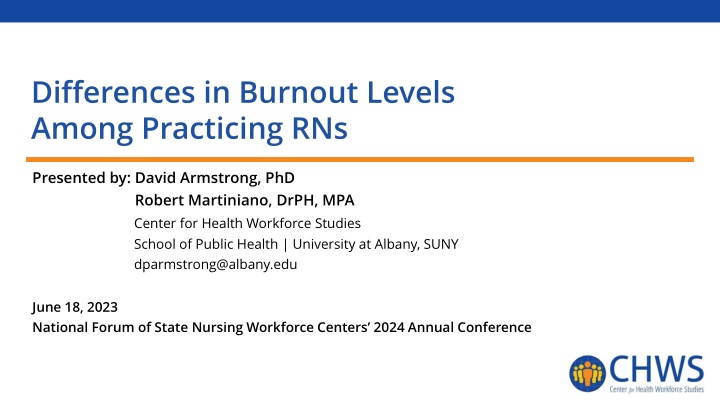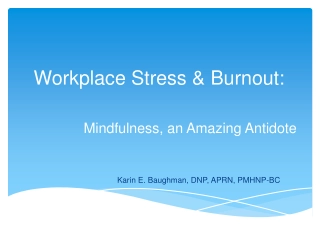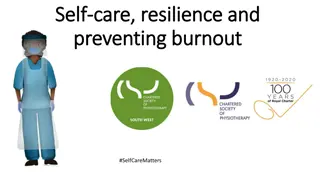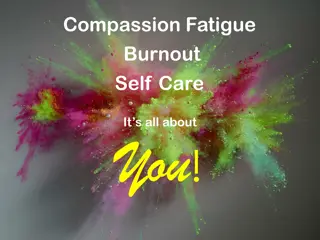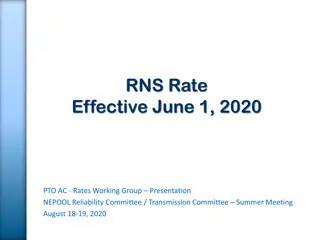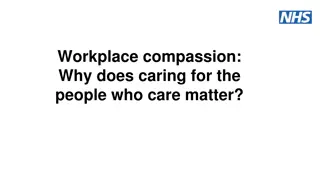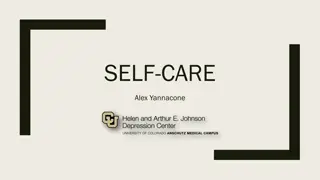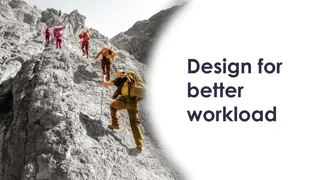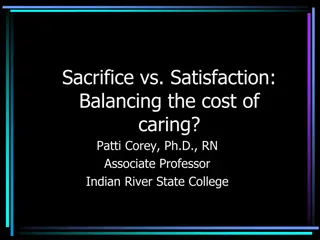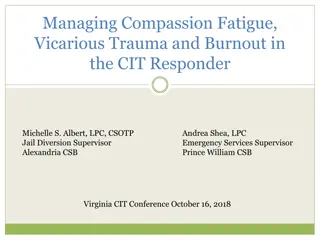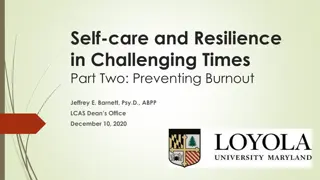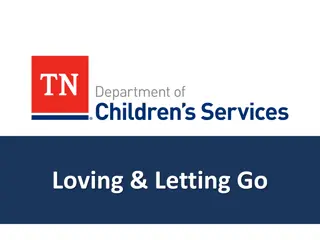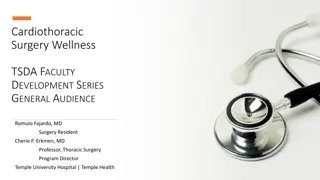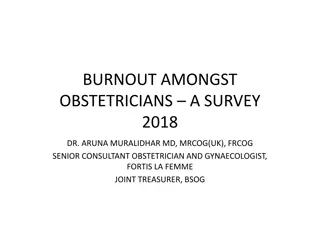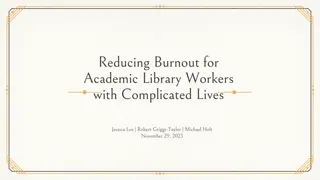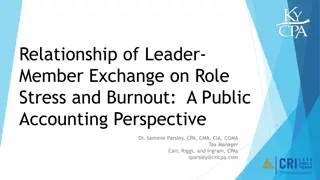Study on Burnout Levels Among Practicing RNs in New York
"Research conducted by the Center for Health Workforce Studies examines burnout levels among practicing Registered Nurses (RNs) in New York. Findings highlight factors contributing to RN burnout, such as demanding workloads and stressful environments, impacting job performance and patient care quality."
Download Presentation

Please find below an Image/Link to download the presentation.
The content on the website is provided AS IS for your information and personal use only. It may not be sold, licensed, or shared on other websites without obtaining consent from the author.If you encounter any issues during the download, it is possible that the publisher has removed the file from their server.
You are allowed to download the files provided on this website for personal or commercial use, subject to the condition that they are used lawfully. All files are the property of their respective owners.
The content on the website is provided AS IS for your information and personal use only. It may not be sold, licensed, or shared on other websites without obtaining consent from the author.
E N D
Presentation Transcript
Differences in Burnout Levels Among Practicing RNs Presented by: David Armstrong, PhD Robert Martiniano, DrPH, MPA Center for Health Workforce Studies School of Public Health | University at Albany, SUNY dparmstrong@albany.edu June 18, 2023 National Forum of State Nursing Workforce Centers 2024 Annual Conference
Center for Health Workforce Studies Established in 1996 Based at the University at Albany School of Public Health Committed to collecting and analyzing data to understand workforce dynamics and trends Goal: Assisting health workforce planners to understand issues related to the supply, demand, distribution, and the use of health workers www.chwsny.org 2
Todays Presentation Background Data and Methods Descriptive Statistics of RN Burnout OLS Regression on RN Burnout Key Findings Strategies to Address RN Burnout www.chwsny.org 3
Background Registered Nurses (RNs) are the largest licensed component of the health workforce RNs work in all facets of health care, from physician offices to hospital inpatient units RNs provide and coordinate patient care, monitor patients conditions, and provide patient and family education www.chwsny.org 5
What Do We Know About RN Burnout? Demanding workloads, poor management and leadership, and overall stressful work environments are known to be associated with RN burnout Burnout is defined by physical or emotional fatigue or exhaustion, increased cynicism at work, and ultimately reduced effectiveness at work Burnout leads to increased RN turnover rates, poor job performances, and threats to patient safety and quality of care www.chwsny.org 6
Data: New York RN Re-Registration Survey RNs complete a mandatory survey at time of their NY licensure re- registration (once every 3 years) o Survey started in November 2022 Survey questions cover education, demographics, practice characteristics, future plans, job satisfaction, and burnout Burnout questions are only asked of those actively practicing as RNs in New York State Sample includes approximately 43,000 New York Patient Care RNs o Data is mainly from 2023 www.chwsny.org 7
Measuring Burnout Copenhagen Work-Related Burnout Inventory 7 Questions: o Is your work emotionally exhausting? o Do you feel burnt out because of your work? o Does your work frustrate you? o Do you feel worn out at the end of the working day? o Are you exhausted in the morning at the thought of another day at work? o Do you feel that every working hour is tiring for you? o Do you have enough energy for family and friends during leisure time? www.chwsny.org 8
Copenhagen Work-Related Burnout Inventory Each of the 7 questions is scored on a 5-point Likert Scale Each question is than assigned one of 5 values based on the answer: 0, 25, 50, 75, and 100 The burnout index is then is calculated by adding up all the scores and dividing by 7 www.chwsny.org 9
NY Patient Care RNs Average Age: 44 85% Female Race/Ethnicity o 55% White, Non-Hispanic o 13% Asian o 13% Black/African American o 8% Hispanic o 12% Other/Mixed Race/Prefer Not to Answer 51% of RNs Work in Hospital Inpatient/Emergency Department Settings www.chwsny.org 11
Black/African Americans Reported Less Burnout Than Other Racial/Ethnic Groups Work-Related Burnout by Demographics, 2023 Low Burnout (0-25) Moderate Burnout (26-50) Hight Burnout (51-100) Average Burnout Score Demographics Gender Female Male Race/Ethnicity White, Non-Hispanic Asian Black/African American Hispanic 15.0% 14.3% 43.6% 43.6% 41.5% 42.1% 47.5 49.4 12.1% 15.0% 26.3% 13.9% 43.0% 44.6% 47.0% 42.5% 45.0% 40.3% 26.7% 43.6% 50.2 48.2 41.2 49.4 www.chwsny.org 12
Older RNs Reported Less Burnout Than Younger RNs Work-Related Burnout by Age Groups, 2023 Low Burnout (0-25) 6.5% 10.9% 15.8% 17.8% 22.9% 44.7% Moderate Burnout (26-50) 38.6% 42.3% 44.8% 45.7% 46.5% 42.7% Hight Burnout (51-100) 54.9% 46.8% 39.5% 36.5% 30.6% 12.5% Average Burnout Score 54.9 51.4 47.9 46.2 42.7 32.4 Age Groups 20-29 30-39 40-49 50-59 60-69 70+ www.chwsny.org 13
RNs With Bachelors Degrees Reported the Most Burnout Work-Related Burnout by Highest Nursing Degree, 2023 Low Burnout (0-25) 19.8% 15.2% 18.4% Moderate Burnout (26-50) 43.1% 41.9% 44.2% Hight Burnout (51-100) 37.1% 42.9% 37.4% Average Burnout Score 45.6 48.7 46.2 Highest Nursing Degree Associate/RN Diploma Bachelor s Master s www.chwsny.org 14
RNs Working in Hospital Inpatient and Emergency Department Settings Had the Most Burnout Work-Related Burnout by Primary Work Setting, 2023 Low Burnout (0-25) 11.3% 15.5% 20.4% 19.5% Moderate Burnout (26-50) 39.7% 46.9% 44.5% 47.5% Hight Burnout (51-100) 49.0% 37.6% 35.1% 33.0% Average Burnout Score 51.9 46.7 44.8 44.6 Work Setting Hospital Inpatient/ED Hospital Outpatient Other Inpatient/LTC Other Outpatient www.chwsny.org 15
RNs Working in New York City and Long Island Reported Less Burnout Than RNs Working in Other Parts of the State Work-Related Burnout by Geographic Location, 2023 Low Burnout (0-25) 18.1% 12.6% Moderate Burnout (26-50) 43.7% 42.2% Hight Burnout (51-100) 38.3% 45.2% Average Burnout Score 46.7 50.1 Work Setting Downstate* Upstate *Downstate includes the Department of Labor regions of New York City and Long Island. Upstate includes all remaining regions. www.chwsny.org 16
OLS Regression Analysis Dependent Variable: o Work-Related Burnout Score Independent Variables: o Gender o Race/Ethnicity o Age o Highest Nursing Degree o Primary Work Setting o Geographic Location (Downstate vs Upstate) www.chwsny.org 17
Results From Regression on RN Burnout Work-Related Burnout Regression Model, 2023 Variable Constant Female Male Hispanic Asian Black Other Race White Age Unstandardized B 67.59 -0.90 **** -1.91 -2.13 -7.80 0.13 **** -0.27 Standard Error 0.42 0.27 **** 0.36 0.29 0.30 0.33 **** 0.01 Standardized B Significance 0.00 0.00 **** 0.00 0.00 0.00 0.38 **** 0.00 -0.02 **** -0.03 -0.04 -0.13 0.02 **** -0.18 www.chwsny.org 18
Results From Regression on RN Burnout Work-Related Burnout Regression Model, 2023 Variable Associate s Master s Bachelor s Hosp. Outpatient Other Outpatient Other Inpatient Other Setting Hosp. Inpatient Downstate NY Upstate NY Unstandardized B -0.69 -0.29 **** -4.71 -7.01 -4.35 -7.15 **** -2.82 **** Standard Error 0.23 0.33 **** 0.30 0.38 0.36 0.24 **** 0.24 **** Standardized B -0.02 -0.87 **** -0.08 -0.09 -0.06 -0.15 **** -0.15 **** Significance 0.00 0.38 **** 0.00 0.00 0.00 0.00 **** 0.00 **** www.chwsny.org 19
Key Findings Black/African Americans reported less burnout than other racial/ethnic groups Older RNs were less likely to experience burnout than younger nurses RNs working in hospital inpatient/emergency department settings reported more burnout than RNs working in other settings OLS Regression model only explains 10% of the variance in RN burnout, indicating there is still much to learn www.chwsny.org 21
Strategies to Address RN Burnout Identify risk factors for burnout Develop and/or expand resources for stress management such as employee assistance programs, wellness teams, and tranquility rooms Provide access to mental health services on- and off-site Address violence against RNs through zero tolerance policies, de-escalation training, and increased security Foster a supportive work environment through nurse engagement and empowerment Promote work-life balance www.chwsny.org 22
Contact Information For more information, please email me at: dparmstrong@albany.edu Connect With Us: www.chwsny.org 23
